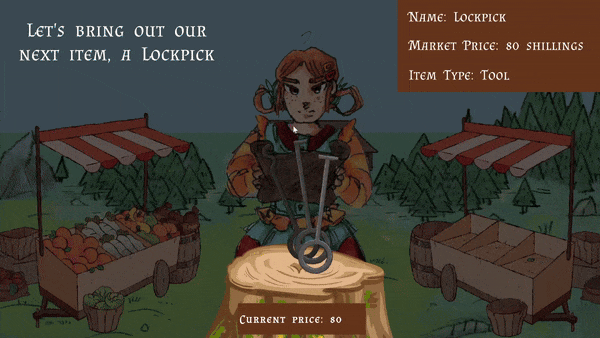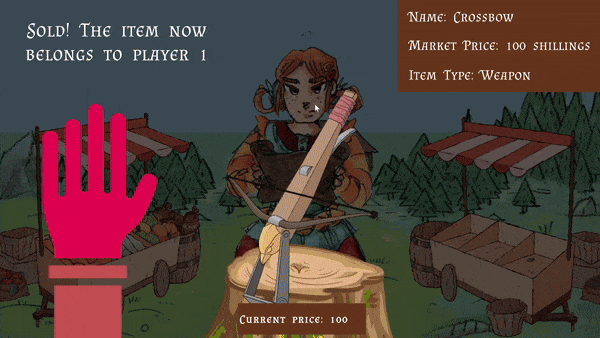Narrative Designs
Here are some of my narrative design related works.

Bid n' Block!
(2023)
Solo Project
ROLE:
Game Designer
Game Programmer
DESCRIPTION:
Bid n’ Block - Auction is an infinitely replayable 2D local-multiplayer strategy simulation game.
Players must compete in an auction to purchase various items.
Players can make bids, sell items, and gain items to eventually acquire all they need to place 3 items in a row on a tic-tac-toe board.

WIN/LOSE CONDITION
Get 3 items in a row, horizontally, vertically or diagonally to win.
If your money reaches 0 or if you opponent gets 3 in a row, you lose.
TARGET AUDIENCE:
Enjoys a competition
Likes board games
Enjoys strategizing, intellectual types
Players who want to improve and get better
Players who explore different possibilities, likes making decisions, challenge themselves and others
TOOLS USED:

Unity, C#, Photoshop
USER EXPERIENCE GOAL
I wanted the user to experience the following:
-
Competition - In a Tic-Tac-Toe Style competition, only one player can win. Players are competing intensely against their opponent for board spaces and items.
-
Critical Thinking - Players have many elements they need to balance, such as their money, the items in their inventory, and what spaces on the board they have taken.
-
Triumphant - When players win against their opponent, they should feel satisfied and hyped up.
-
Childish/Humor - When players trick their opponent into buying an item by raising the price super high, they should feel giddy and smart.

THEME
For our assignment, theme was "Infinitely replayable". I gravitated towards designing a multiplayer game because each time the player plays against other opponents, something new will occur.
I thought the process of an auction was interesting. There are many elements of an auction such as bidding, raising, selling etc. There is a competitive aspect of auction that I found interesting. I thought if there was a multiplayer where players had to compete for the same items that could lead to a fun and intense gameplay experience. I wanted the gameplay experience to feel strategic, where players need to buy the right items and manage their money. I didn't know of any other games that were themed around an auction, so I decided it was a good opportunity to explore the idea.
As for the fantastical and medieval theme of the game, I wanted the players to be betting on interesting items, old items that are magical. I thought it would also be funny to hear the auctioneer speak old english and using shillings as currency.
STRUCTURE

High Tension
During the auction phase of the game, a timer will start, in which players have a limited time to raise, if the timer runs out, bidding ends
Players can then press a key to raise the price by 10 shillings, with the player who presses it faster being the one who raises first
When the bidding ends, the player who was the last to bid automatically purchases the item.
Balancing
During the inventory phase of the game, the player who lost the bidding round gets to go first, which means if they had items in their inventory from previous rounds, they get to use it first. This gives them a slight advantage.
Strategy
Boards are generated at the beginning of each game session. Each space on the board will describe an item. Ex. A sharp item, a magical item etc. On each player’s turn they can choose to place something on the board to permanently take over that space. However, the other player may catch on and stop them.
Players can also keep all items in their inventory and place them all in one go.
Enables players to keep more items in their inventory so that the other player doesn’t guess what their next move is.
GAME MECHANICS
GAME BOARD
The random generation of the game board tiles creates a sense of novelty as players will need to think about different strategies each time. The tic-tac-toe mechanics of the game board was created because it was a fun way of telling players what items they need to buy without presenting a plain list to them.
It allows both players the freedom to choose what to buy to better their strategy, to make it feel less like a chore. It also gives players the ability to misguide their opponent on what they plan to get. This can lead to the player raising the prices on items to trick their opponent into thinking they want the item, only to not buy the item and waste their opponent's money.


AUCTION
In the auction, as each player raises the price, the time left over for the next bid decreases exponentially. This creates a sense of tension and pressure for the players. If they hesitate on buying an item because the price is too high, they may lose out on their chance to buy it.
INVENTORY
The player's inventory is only visible during the inventory phase of the game. Both players are able to see what their opponent is holding in their inventory. This creates a memorization aspect to the game. Additionally, players can only see how much money they have left on this screen as well. This means players should keep track of how much money they have before a new bidding round begins, or risk raising prices higher than they can afford. Reaching 0 shillings is an automatic game over, so if players fail to remember their money count, this enables the opponent to trick them into paying more than they have.
Another aspect unique about the inventory phase of the game, is that players can choose not to put an item on the board during their turn. The reason for why this may be a good strategy is that players can leave their opponents in the dark about what items they plan to use, and what items they plan to place on the board. I thought this added to the difficulty of the game, where players need to predict where their opponent wants to do next.

ITERATION PROCESS
Iteration 01
In this build, the basic features of the game are implemented, bidding, selling, and placing specific items on the board.
Playtest feedback:
-
Pacing felt too slow
-
Game time felt too short
-
Unsure how much time is left to raise when a player raises
-
Maybe the items purchased by the players could be used, and by using it, different effects could happen.
-
Not clear which player’s turn it is because the icon at the top right corner is too small

Iteration 02
Pacing was increased. After a player raises, immediately their opponent can chime in and bid higher. As more and more rounds of raising continue, the total time left to bid decreases, making it more and more fast paced. Additionally, a timer bar now pops up, indicating to players how much time they have left before the item is sold.
Background implemented in player inventory screen, making it clear which player’s turn it is.
Added item effects:
-
Dagger - player can stab the other, making them too injured to bid next round
-
Elixir - player can drink it to heal or prevent upcoming damage
-
Hammer - player can use it to change the category of an empty space on the board, preventing their opponent from winning
Playtest Feedback:
-
Too much money, bankrupt lose condition near impossible
-
Still too easy for players to win
-
Needs Tutorial
-
Item that can be used during auction phase
-
Need some kind of item to take over a claimed space

Iteration 03
Lowered initial money count. Created a how to play page to teach players basic mechanics and game flow. For this iteration the focus was to make it more difficult for players to win, and provide balancing losing players to catch up.
Added the following items:
-
Crossbow - Expensive, but can be used during the auction phase to fire and injure the opponent, preventing them from bidding further.
-
Quill - Can clear a spaced claimed by the opponent. Make it empty again.
-
Lock pick - Can steal 50 shillings from the opponent. Enabling the bankrupting strategy.
Playtest Feedback:
-
Show inventory before first round so players know how much money they have
-
Larger game board (9 grid tic-tac-toe)
-
Undo button when misplacing items on the board
-
An item that forces the opponent to bid
-
Separate displays so the opponent has less information about the player’s inventory
-
Add notes where player can write down information for themselves
